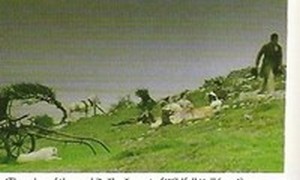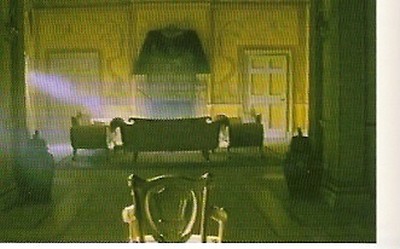Ellen and Jim Have a Blog, Too
We are two part-time academics. Ellen teaches in the English department and Jim in the IT program at George Mason University.


Two Bronte Movies: _The Tenant of Wildfell Hall_ & _The Namesake_ · 31 October 08
Dear all,
Perhaps during this worrying last weekend (waiting anxiously in the hope Obama and Biden may win), some content about matters other than the election will find welcome.
I’ll begin by mentioning that the Wompo festival of women’s poetry starts tomorrow: Wompo Festival Site_. It goes on for all month: you can go and read about poetry or poetry itself or all sorts of comments by women on various issues, reviews of writing (I’ve contributed two, on a book on 18th century women’s poetry and one on a Renaissance woman poet), and good blogs (I’ve contributed one). And of course there are my 30 foremother poet postings, beginning with Castelloza, a troubadour woman poet.
I said in my last diary entry, I would write a separate blog first on David Nokes & Janet Barron’s, Suzanne Harrison & Mike Barker’s Tenant of Wildfell Hall and Mira Nair & Sooni Taraporevala’s Namesake:
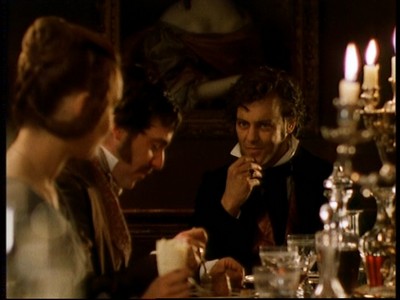
Arthur (Rupert Graves) and Helen Huntingdon (Tara Fitzgerald) at table with friends, Tenant of Wildfell Hall, 1996
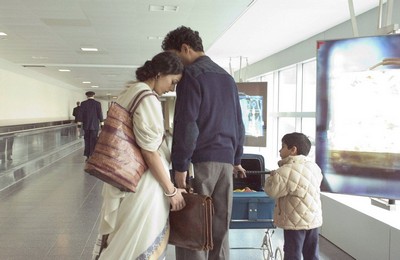
Ashoke (Irrfan Khan) & Ashimi (Tabu), returning with son and baby daughter to India after grandfather’s death, Namesake, 2007
I look at what is done to Bronte matter, how it’s expressed, in two recent costume movies. (I’ll refer only to screenplay writers’ or director’s names as responsible for this or that part of the films for efficiency’s sake.)
The edge of the world
I’ve not read Anne Bronte’s The Tenant of Wildfell Hall in a long time. As I recall that was when I was all alone here in Alexandria, no friends on the Net, and no job at all, no one to clue me in on which modern books to try and little means to find them beyond local bookstores. I might as well admit up front that even then I never read it properly in that I skipped the tedious didacticism and interspersed with story and character and adult theme matter.
Still from what I remember it seems to me Nokes & Barron made intelligent use of the story and characters. Some is over melodramatic & over determined, e.g., how Helen Graham (Tara Fitzgerald) came to love this ne-er-do-well, Arthur Huntingdon (Rupert Graves) is one of these stories where a young woman drinks down poison and is irresistibly led to chose misery, and ignore what is in front of her; that is, they don’t even get along with the man in casual conversation as he is a boor and coarse. I don’t say this is false, but that to make one believe it you have to go deeply into someone’s destructive impulses. And they haven’t done that, just assumed women are like this.
But the account of the marriage itself is believable and powerful. Quickly Arthur is bored and irritated; Helen has a different nature and really wants to live a quiet reasonable life; he wants sex from her no matter what her condition. She takes seriously nasty behavior in public and will not accept it for herself. She does like him, at least respects and wants him to respect himself as she understands it. The movement into alcoholism goes too fast and is not understood, it’s only a surface presentation. But Nokes & Barron aren’t interested in his alcoholism (while Anne Bronte was); nor very much in her life as an artist (but then neither is Bronte), except for showing landscape:
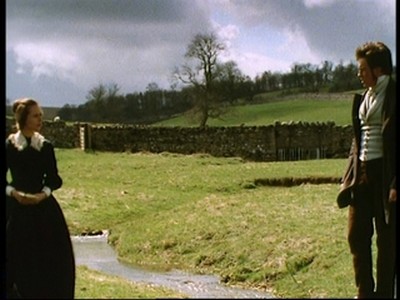
Helen Graham and Gilbert Markham (Toby Stephens) in meadow
Rather they are delving candidly the bonding of two people into a sexual relationship who are otherwise unfitted for one another.
On Trollope-l we had been reading and discussing the novels of Ellen Wood as reflections of womens’ issues and lives in the Victorian novel; and as my proposal to write a paper on David Nokes & Janet Barron & Robert Bierman’s film adaptation, Clarissa (1991), I was naturally watching this film with both perspectives in mind: how does the film reflect womens’ issues today and the lives of Victorian people; and does it connect to the mindset I find in the 1991 filmic Clarissa.
First, the Clarissa connection: As I’ve written on this blog, Nokes and Barron’s film presents the view that Lovelace is a cruel man whose point of view on human relationships derives from a culture which encouraged in him the worst of violence aggressive impulses, arrogance over his rank and place and his value (no matter what he does), and sheer domination and competitiveness as how to spend one’s hours. I think this is a reading of Clarissa which may be said to be more like what we find in Germaine de Stael’s depiction of male aristocrats in Delphine—and come to think of it is in line at least with Shadwell’s Libertine. By contrast, Gilbert Markham represents the decent ethical (if narrow) man:
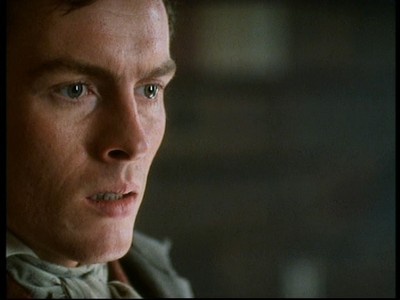
Gilbert Markham (close up)
Well, the way Nokes and Barron presents Helen Graham Huntingdon’s case against Arthur Huntingdon, her alcoholic husband is to turn the stress in the novel on her upbringing of her child, her motherhood into an instance of the two of them struggling over how the boy will be brought up. In part 3 of this film adaptation he takes the child back and proceeds to teach him behaviors that are violent, cruel, ugly: to hunt ruthlessly, drink, be mocked and so he will mock others, especially if they show any emotional weakness. He has taken a governess to be his mistress openly, and we are led to understand his awful behavior as a result of precisely these values. In the first part of the film adaptation Helen was told by those she was surrounded by in the place she fled to, that she was bringing up her boy wrongly: she should let him follow his “manly” impulses (which meant in context killing birds, and “sinful” behaviors of wantonness of all sorts). Helen wants to bring him up to be kind, courteous, controlled, good, in short.
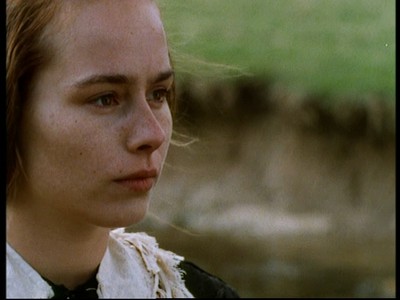
Helen (close up)
Second, Victorian lives and womens’ issues. The mini-series Tenant Of Wildfell Hall is but 3 episodes for a big thick book, and time was taken out for Helen to debate with the mother, Mrs Markham (Pam Ferris) of Gilbert Markham (whom Helen ends up marrying) how to bring up a son or daughter. Mrs Markham insisted that the son should be allowed to be rambunctious and get hurt and not be protected, while a girl must be sheltered from all experience; Helen said both should be sheltered and was against teaching a boy to drink or be amoral (which is what they were really urging her to do). In an article I read about Ellen Wood’s novels and The Tenant, Elizabeth Gruner quotes at length a long conversation between the two women rivals, Mrs Hale and Isabel (according to Gruner, the only long one they have) which is about how to bring up children, and what is said is by the “good” conventional Mrs Carlyle is that a woman should give over the daily discipline of her chlidren to her governess so she is there to cater to her husband or he’ll tire and leave her. Isabel is the governess and so she’s doing this—the drudgery. The Tenant of Wildfell Hall also treats Helen’s new husband, Gilber Markham in terms of his relationship with his domineering mother.
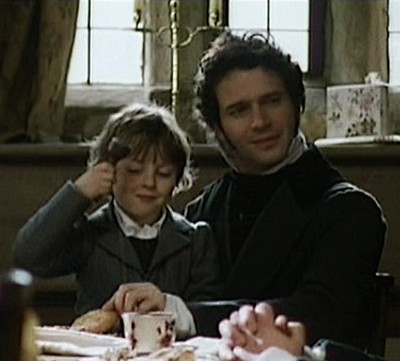
Arthur teaching his son to be “a man” (drink, womanize, show off)
I had just gotten my Virginia Woolf miscellany for this season and
began to read, and found myself reading about her Three Guineas where she argues that we must change our education in schools and life to produce “the kind of society, the kind of people who will prevent war … ” and “not teach the arts of dominating other people, not the arts of ruling, of illing, of acquiring” things as the aim of our existence and “capital” for more. Subjects should be those which can be taught and practiced by poor people, medicine, math, music, painting, reading, and “the art of understanding other people’s lives and minds … the way in which the mnd and body can be made to co-operate.”
This what Nokes and Barron are on about in both film adaptations. In the first, Clarissa, the negative results of bad education, in the second, The Tenant, the education itself shown to produce an Arthur Huntington (beats his wife too, spends his life drinking, laughs at learning to play music, at drawing, at reading). I’ve not gone further in Nokes’s biography of Gay but I know his biography of Austen has this perspective on her family and can see it coming out in the depiction of Gay’s world.
This costume drama, like Clarissa, makes astute use of stills.
Here’s the child backwards, an allusion to The Shining; he feels menacing:
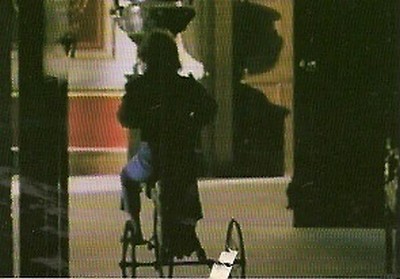
Helen finding a home and a reflection of her psychological mood in the landscape:
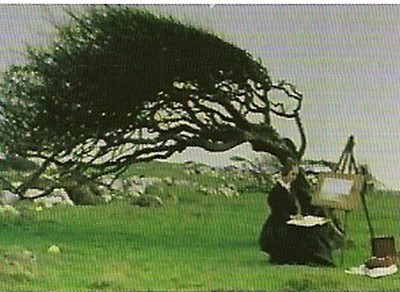
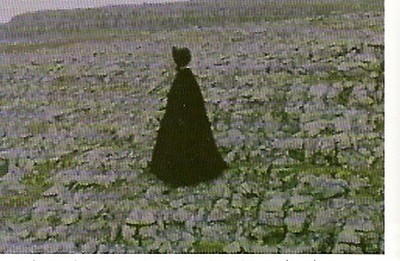
It’s a case of admitting that the fetish over the original book should be put aside and show appreciation of a modernization which makes the matter relevant to people’s relationships today. What I love about costume drama is the costumes allow for a serious consideration of issues which when people are in contemporary costume the film-makers hesitate to do.
Yesterday someone explained to me some references I’ve seen
repeatedly in the US campaign: it seems that Sarah Palin made a joke on her acceptance speech; what’s the difference between a hockey mom and a pitful. Answer: Lipstick. Har har. This makes a joke of violence. As a mother she is teaching her sons violence; as a person she likens herslf to a pitbull with lipstick (a sexualized vicious dog). Sickening. And this is put before US citizens to vote for.
Well I think to myself these costume dramas have an important
function of countering this war-mad society of greed mongering people (in the US $700 million to banks with no strings attached, and no health fcare for millions, no help against foreclosures). Alas the Woolf Miscellany reports that most young people in colleges have only heard of Virginia Woolf because of Albee’s play which exploits prejudice against her as a learned bluestocking :( Three Guineas should be assigned as required reading and film adaptations of classics not just shown but explained for real.
***********
I know I have discussed Mira Nair’s The Namesake before, as well as the novel just after I read it, but I never discussed the film with the knowledge of the book in mind, and if nothing else, watching the film after having at long last ingested this wonderful novel, showed to me how important it is to know the source text in order to understand the movie by comparing them.
The film was beautifully done and seemed to focus on the Ashoke (the young man who in an arranged marriage weds a young woman in India & takes her with him to the US, Massachusetts, played by (Irrfan Khan) and very secondarily Gogol (Kal Penn); the novel as it opens and into it, on the other hand is told mostly from the point of view of Ashimi (Tabu), the young woman and then mother. It’s touching and is about the Indian diaspora which I’ve read is central to Indian cinema. Lahiri records shima’s wrench in leaving a culture one knows and all the people she’d een surrounded by. We see how lonely is Ashimi in the circumstances of a wife at home with little money.
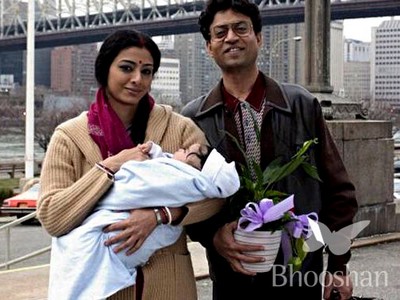
Ashimi and Ashoke in a touching photo (taken within the film)
The book is not great (not original in the way of Alice Munro’s fiction to take a close parallel type contemporary fiction) but it is good and is literary—has genuine style and thought. It reminds me of too of the types in Diana Philips’s book on women’s fiction since WW2, perhaps the Aga saga. Philips argued the much respected books by women fall into the same categories or types that the thinner shallower ones do. As I enjoyed reading Emma Donoghue’s Slammerkin as an intelligent self-conscious repeat of the unpoliced erotic texts by women I’d read then, so this Lahiri seems a book-of-the-month club type that I liked very much too: the dowdy book.
Yet I was somewhat disappointed when I finally saw the movie after reading (hearing) the book. While I was moved by the end of it (as the story is moving and the actors were all superb), it seemed pedestrian. It was (I think) of the apparently faithful type, except of course it naturally had to compress, and the result was, particularly towards the end, the story of the young man, Gogal grown up, his first affair with a rich modern Amerian girlfriend, Maxine (Jacinda Barrett) and then his Bengali-Frenchified young wife, Moushumi Mazumdar (Zuleikha Robinson) was superficially presented.
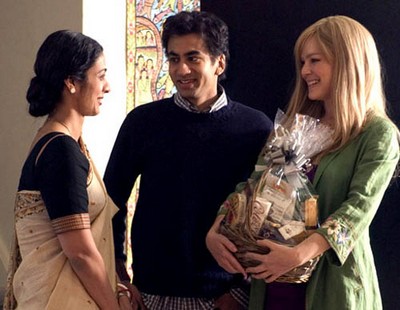
Gogal (Kal Penn) and Maxime (Jacinda Barrett) meeting Ashimi
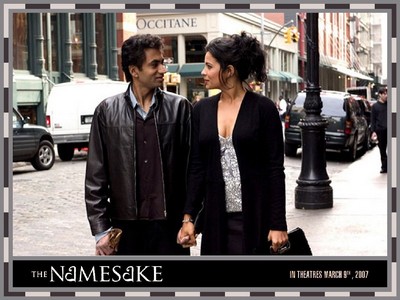
Gogol and Moushumi (Zuleikha Robinson) delighted to discover one another
The depth was given to Ashoke and Ashimi’s story; theirs was made the center of the film & developed meaningfully; but as it’s only one half of the book, and the decision to be faithful and not leave out any major characters or hinge points was made, the last part hurried along to include over 1/3 of the novel. The time would have been better spent developing the Ashoke and Ashimi story more deeply by filmic techniques, dramatic scenes and so on.
The film thus taught me how like Wuthering Heights this book is. Lahiri’s book is about generations and evolution over time of people within a family. Films of WH sometimes fail because they don’t want to present the next generation as fully as Emily Bronte meant them too (the 1992 film with Binoche and Fiennes does and it’s part of its superiority).
There was also a reluctance or chariness really to present in full graphic feeling the difficulty of assimilation as well as Ashimi’s return to Indian ways for 50% of the year. It skipped over the meaningless of Moushumi’s affair itself (an important point in the book) but substituted nothing else; the class conflicts of the last part where Gogol is unable quite to enter the upper middle class of whites was lost, partly because there wasn’t enough time, but also it didn’t interest Nair. She wanted to give us a short travelogue of India (family goes visiting famous places) and Ashoke’s traditional funeral.
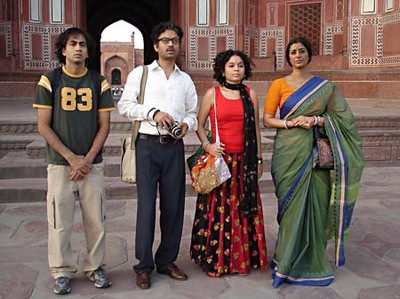
At the Taj Mahal
They rearranged the scene where the father explains to the son why he named him Gogol; it does not come from a spontaneous crisis and was put at the point of the film where a central climactic scene usually occurs. But since the depth of the film was the story of Ashimi and Ashoke (Tabu stole the show as did Khan), it was flat.
The real knot of the film was Ashoke’s death and a new interpretation was given there. We were to feel he died because his wife wouldn’t go with him. In the book Gogol is the one blamed for not seeing his father off at the airport; not that that would have saved him, but that would have made Gogol feel better and his father less alone for that time. In the book Ashimi has become partly assimilated (she has a small job in a library; she has a few friends; she has her house and routine and comforts); he is doing research and there’s nothing for her to do in Ohio. So we admire and understand. In the film he wants her to go with him, and urges and nods, and she refuses, and the whole feel is he died because she wasn’t with him. Bad decision, foolish woman gets her punishment.
The film didn’t add anything except of course (a big except) it showed different things than a book and so we have visual representations of our characters, of the Nothern US. There was a funny moment when after their marriage Moushumi and Gogal half-dance in the Bollywood way; it’s a light mockery. Perhaps the most original moment filmically of the film.
Ah well. I still enjoyed it for the many reasons we all enjoy movies. I had people with me in front of me and experience visually places (NYC too) but it was not what it could have been. It’s an example of why apparently faithful films can be disappointments. Nair needed to be bolder and follow through on her own interests and also see what her presentation of the wife’s decision was figuring forth.
***********
And why discuss these together? I would define The Namesake as a semi-costume drama. The female characters were in Indian costume all the time, and the man at important liminal turns of their existences. this film had the types of women’s fiction and other women’s films seriously presented with compassion and intelligence.
What I am wondering is this: why do people not write about costume dramas more seriously in large books. The only book I know of is Pam Cook’s Fashioning the Nation, which is just a beginning explanation and defense, and the occasional essay in an anthology. Reams of books on “classic” (i.e., older) pop movies from cinema, mostly masculinist in perspective and more recent ones. I will be told well they are seen as women’s films, they embarrass because of their open use of emotionalism and luxury, they are on TV. But among intelligent critics (there are some) there is something beyond this.
It is the costume probably, people are such concrete pragmatic
creatures and wars are fought over costumes in religion. It allows
for open explorations not seen elsewhere (kind, non-predatory, sensitive men) but sometimes I think what I really would like to do is a book on costume drama. Too big I know. Better to have the Austen focus and work through that. And that’s what I’ll try in little next time.
The past put behind us in The Tenant of Wildfell Hall
Ellen
P.S. I received a correction which I can’t make a separate comment for (as commenting is closed). I include it as Nota Bene:
“Ellen:
While reading your thought-provoking diary entry regarding this novel and adaptation, I happened to notice that the seventh picture including is captioned as “Arthur teaching his son to be “a man” (drink, womanize, show off)”. The picture is really of James Purefoy as Mr. Lawrence, Helen’s brother, who is holding little Arthur on his lap at the Markham’s party.
Best,
Janelle Vandervort Dvorak”
--
Posted by: Ellen
* * *
Comment
- More on Lahiri's novel, The Namesake: It’s read aloud wonderfully well by Sarita Choudhury. Ivette listened with me for a while and found it a very sad novel—it certainly dwells on the heroine’s sense of loss. At this point I’m into the early years of the son, Gogol. They’ve a daughter whose nickname is a Russian one (and so allusion) too: Sonya.
My friend, Joan, says she loved the novel and I know a few others have read it here too. I finally came to the end of this novel and I was deeply moved by it. Lahiri builds slowly and her effects are from the cumulative narrative I see. Her great subject is displacement. Sarita Choudhury’s beautiful measured reading was a little ruined (and the final experience slightly spoilt) because Random House audio is one of those companies who don’t trust their readers to revel in a book itself. Music was added in the last few minutes. Sigh. I’m writing this as much to say this about Random House Audios (I’ve seen this sort of thing in their audiobooks before).
While I was reading the book spoke out to me directly and I thought of a line I read by Terry Castle about women’s novels for women: “a certain strengthening awareness can be pssed—from woman to woman —through the genre of the novel itself. Paradoxically, the last part began to fall off when the character to the fore was a woman type I usually can’t identify with. About half of the novel is told from the viewpoint of the young woman who marries traditionally in India and grows old in the book, bringing up her family; it ends with her husband’s death; another half is by the son (the namesake); it opens with the father who dies suddenly at the end. But then there is this sequence about the young man’s wife: they get divorced by the end of the book. I like the good or traditional heroines: Fanny Price not Mary Crawford, Alice Vavasour, the grave heroine; Emma is a problem for me for the traditional heroine, Jane Fairfax, is marginalized; a modern novel might take Miss Bates for the center (Pym would). Well the woman turns out to be betraying the husband through sex and other ways. I found myself furious oddly: I hadn’t liked her as amoral somehow and so easy in life. I was supposed to sympathize I think, butI was gripped by the story. Dialoguing with other women through books you see. We reach out.
To conclude, I did try a mystery recently and came to the conclusion I just don’t like the genre. Elisabeth Hyde’s The Abortionist’s Daughter, said to deal seriously with the issue, oby a woman therwise a lawyer involved in such cases. I realize the dialogue was realer than Lahiri’s, realler people (less idealized). The murdered abortionist was a woman (in the book), with the daughter being a strong character (said very mean things to the mother and vice versa). I couldn’t bear the formula and lowness so to speak, a kind of sordidness I found in Susan’s Hill’s mysteries too. Rather than escape (which Lahiri allows) I find myself in these books confronting messy cruel life where there was nothing redemptive or consoling. The formula made things worse as I had in my hands a commodity. So I gave up.
E.M.
— Elinor Oct 31, 11:17pm # - A summary of the article mentioned in the blog:
I’ve come across an interesting article in Tulsa Studies of Women’s Literature by Elisabeth Gruner on Anne Bronte's Tenant of Wildfell Hall and Ellen Wood's East Lynne in the context of Caroline Norton’s horrible experience of divorce, infamy, and loss of her children in the Victorian era and a novel Norton wrote (not well known), Lost and Saved.
Many readers of the three novels reading them discuss the love stories primarily or the transgressions of marriage sexually or the drunkenness and Helen Graham’s flight from her husband. Gruner shows that unless you figure in the stories of motherhood, which include dialogues or debates on how to bring up a child (boy in one way and girl in another) you lose the central meaning of these novels.
What Gruner shows is the society around these women use the women’s attachment to their children to control their behavior and make them stay with husbands, no matter how abusive or difficult the husband may be. The Victorian novels show the hypocrisy of the claim that the society cares about the welfare of the child first; what the society’s rules and customs are set up to do is make the woman stay with the man and obey him. If she doesn’t, she’s punished through the children most of all – but in other ways too.
These Victorian novels have a similar mindset: in none of them is the idea the woman’s first and foremost function in life is to be a mother. She belongs in a private world inside a family, and only leaves it because she is forced out; all of them adhere to the idea that only in extremis should the woman reveal what happens in her private life, no matter how bad it is. And we see that in the court case of Norton revealing her private life continually went against her; whatever she said was used against her somehow.
The interest in each of the novels is the obstacles set up before the woman to these wonderful goals. The novels have conventional outlines and endings, but the obstacles are dwelt on at length and these show the truths of their lives.
One astonishing thing to me was a parallel I recognized between East Lynne and of all books, Graham Swift’s Last Orders. In LO there is an improbable story. A woman, Amy Dodds, spends 50 years, twice a week going by bus to a home to see a totally imbecilic daughter she gave birth to. She says she went in the hope of just once, just once, hearing this daughter acknowledge her as her mother and indicate she felt something for her. Never once did this imbecilic child ever recognize Amy as her mother. In the novel the father will not have anything to do with this daughter and Amy has gone partly to revenge herself on him for not accepting the daughter and not loving her Amy (it was a shotgun marriage).
Well this is a parallel with East Lynne. Isabel Vane’s great torture is that her children do not recognize her as their mother, they never say they love her as their mother. In the movie and play adaptations of East Lynne, but not the book a famous line is spoken: something like “Dead, dead! and never recognized as their mother.” This is total madness—or so it seems to me. What morbid rot. A pathological outgrowth of imposed norms so incessantly inculcated it becomes a form of insanity.
I’ve realized more than once just how wallowingly sentimental Last Orders is. The men go on this sentimental journey; they are pilgrims in a progress, like Chaucer’s pilgrims stop off at Canterbury &c&c, but not been able to think through the craziness Amy’s trips represents.
Anyway if I didn’t manage to read all of East Lynne (and never did finish the book Tenant as insufferably tedious and moralistic), I’ve read enough to get a lot from this article. It’s not uncommon with me to prefer an article to the novels the article is about, find more in it.
E.M.
— Elinor Nov 1, 7:52am # - I was very interested to read your thoughts on The Tenant of Wildfell Hall and the adaptation, which I did see at the time but don’t remember in detail and have just added to my list at the DVD club. Since reading your comments, I have been racking my brains as to which other novel I’d read fairly recently where a wife gradually learns to despise her drunken husband and fears her son will learn to follow in his footsteps.
I thought I was thinking of an 18th-century novel, but have just realised that in fact I was thinking of Thackeray’s 18th-century pastiche in Henry Esmond, and the relationship between Rachel and Francis, where, again, motherhood is central – she is furious at signs that the younger Francis may be following in his footsteps. I also remember a passage about how Rachel is aware that her mind is above that of her husband’s, but she has to try to brainwash herself into ignoring that fact and pretending that she should be subservient to him – something she can’t bring herself to do.
I think there may also be discussions of what age a child should start to drink in Pamela 2 though I’m not sure about this – in any case, this whole question of how 18th and 19th-century novels look at the training to be a man or a woman is very interesting. Thank you for summarising Gruner’s article on this.:)
I liked both the book and the film of The Namesake very much, and have enjoyed reading your blog on these and looking at the stills, although I don’t remember the story now in enough detail to comment.
— Judy Nov 1, 1:54pm # - From Tom:
“Me too Ellen. I frequently prefer reading a “good” article about a book, in the end, more than the “source” text/book itself. After all, if the article or essay is quite good it ought to stand by itself and make its own claims on our attention. Funny, but sometimes I feel guilty about my preference for what’s often mistakenly referred to as the “secondary” literature. It’s all good (or not).
Thanks for the fine post!
Tom”
— Elinor Nov 1, 7:41pm # - From Maria on Austen-l:
“Hi Ellen—thanks for posting the blog on Tenant; as an Anne Bronte supporter, I was very interested in reading it. When the mini-series came out, I did watch it, and remember being extremely disappointed. No longer remember the exact reasons, but I remember feeling there were structural problems which detracted from the interal coherence; a lack of humor (Anne is very, and dryly funny); and the surprises in the story were warped in the mini-series.
One note: Anne was, indeed, very interested in Helen’s art work, both as a means of making a living and as a doorway to perception and psychology, Helen’s and the viewer’s. Anne herself, like her siblings, was an enthusiastic artist; like Emily, she defied then-feminine convention and drew “from life” in addition to copying from books, and she understood what went into creating work on canvas.
Just a nitpick.
Maria”
— Elinor Nov 1, 11:23pm # - I did want quickly to reply to Tom and will try to reply to Maria and Judy sometime tomorrow.
It’s absurd how much courage it takes to say what is the obvious: often a critical essay is superior to a novel. Why should that not be? The overrating of novels and fetish of originality never ceases. Many novels are trash and many critical essays awful, but great work in both kinds is creative.
What’s created is different but the conception and understanding of what we see in the creastion is, say, as important as the creation and in films as analysing the characters. That’s why movies need intelligent criticism and the loss is they so rarely get it so we are left at sea with what is put in front of us which is so visually or sensually rich.
The hard thing is to extract the thought from the image. I.A. Richards said language is the completion of the intuitions of sensations and they can’t do it themselves. Words are the places where regions of experience are brought together to make sense and only then can we apply them to our lives. People who write this way make little money from the writing since most people read frivolously and go to the movies shallowly (and many can’t begin to get beyond the literal), but for those who do, this is where we go beyond animals, how our minds grow.
All this, Tom, is in the opening of Geoffrey Wagner’s Novel and Cinema. He’s good on individual movies too, only he’s never heard of a book or film by a woman apparently :).
Ellen
— Elinor Nov 1, 11:47pm # - Thank you to Maria. It has been a long while since I read The Tenant. Charlotte Bronte also uses the skill of drawing (and painting) taught middle class girls in her Jane Eyre: there the paintings are symbolic landscapes. It’s just that as I recall the book, so much space is given over to straight moralizing. It’s as if having broken the taboo on telling of domestic violence and alcoholism (very common in fact), she felt she had to compensate with stretches of didacticism.
Judy, I’m interested in the structure of these books, and in the use of closely tied repeating patterns in generations seen in Wuthering Heights. So bringing in Henry Esmond is a propos. There the interest is in the incestuous love of son and mother, but we do have intertwining generations (which form the interest in Emily Bronte, Jhumpa Lahiri, and I sense I have of other womens' books though I can't recall one this morning ). The closest Austen gets to this is MP where Fanny and Edmund are repeating Sir Thomas and Lady Bertram’s patterns (unless you see Elizabeth Bennet as also repeating her mother’s position). It interested me that with the exception of the 1992 WH, the film-makers of Namesake had the same kind of trouble with presenting this as the film-makers have in presenting it for Wuthering Heights.
E.M.
— Elinor Nov 3, 6:19am # - Clare responded:
“Maybe the problem will resolve itself. The apparatus for cogent literary criticism took some time to evolve. Perhaps because of the richness and dept of intelligent film, it will take longer to evolve it’s own intellectual criticism. I did wonder if we’re even at the beginning of this process. Surely the categorising into genres was a precursor to a critical framework. If that happens to film in a more organised way, then perhaps that will be the start of the critical process, Does any of that make any sense?
Clare”
I reply:
Dear Clare,
Perfect sense. You might say with respect to public valuing of movies, we are at the point reached for the novel just before Walter Scott. We begin to get the first serious criticism of novels in reviews and newspapers around 1820. Yes I think categorizing of enormous importance—for we must define a thing’s characteristics and conventions to explore it. I will try to do that in my book— but have learned common readers are bored by talk of categories :)
Ellen
— Elinor Nov 4, 12:02am # - From Maria on Austen-l:
“Hi Ellen—thanks for getting back to me.
It’s funny how you remember a lot of didactic stuff in Tenant: when I first picked it up to read, it was after being fed all of Charlotte’s negative perspective on the novel, and echoes of how boring and badly-structured it was from other reviewers. Therefore I was shocked to discover how rich and humorous the work is, how careful, in fact the structure is and how completely and convincingly Anne is able to see through the eyes of of characters like Huntingdon and Markham. One of the huge caveats of Tenant has nothing to do with what Anne wrote but with the criminal hash that editors made out of the novel, playing around with the structure and the language, and wrecking continuity, among other things. Here’s a summary of what you have to be careful of, taken from a lovely website about Anne by Mick Armitrage:
http://www.mick-armitage.staff.shef.ac.uk/anne/mutilate.html
(If you’re interested, the site also has an unfinished sketch for a monologue for Anne composed by yours truly).
Therefore, if you, or anyone in the Austen group ever want to pick up Tenant of Wildfell Hall, be careful to choose an unmutilated copy rather than one of the several travesties still out for purchase.”
— Elinor Nov 4, 12:35am # - Come to think of it, Maria, it’s true my copy of The Tenant of Wildfell Hall is not a modern scholarly paperback, but an old-fashioned hardback of the type one finds in sets of novels meant for book clubs. I didn’t realize there is a serious textual problem. I shall buy myself a decent edition. And go over and read your monologue later today (after I vote—Obama & Biden!).
Ellen
— Elinor Nov 4, 6:20am #
commenting closed for this article

